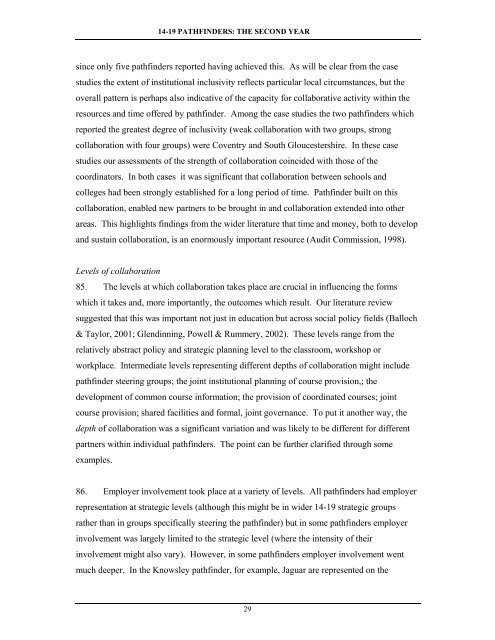Collaborative Approaches to 14-19 Provision - Communities and ...
Collaborative Approaches to 14-19 Provision - Communities and ...
Collaborative Approaches to 14-19 Provision - Communities and ...
- No tags were found...
You also want an ePaper? Increase the reach of your titles
YUMPU automatically turns print PDFs into web optimized ePapers that Google loves.
<strong>14</strong>-<strong>19</strong> PATHFINDERS: THE SECOND YEARsince only five pathfinders reported having achieved this. As will be clear from the casestudies the extent of institutional inclusivity reflects particular local circumstances, but theoverall pattern is perhaps also indicative of the capacity for collaborative activity within theresources <strong>and</strong> time offered by pathfinder. Among the case studies the two pathfinders whichreported the greatest degree of inclusivity (weak collaboration with two groups, strongcollaboration with four groups) were Coventry <strong>and</strong> South Gloucestershire. In these casestudies our assessments of the strength of collaboration coincided with those of thecoordina<strong>to</strong>rs. In both cases it was significant that collaboration between schools <strong>and</strong>colleges had been strongly established for a long period of time. Pathfinder built on thiscollaboration, enabled new partners <strong>to</strong> be brought in <strong>and</strong> collaboration extended in<strong>to</strong> otherareas. This highlights findings from the wider literature that time <strong>and</strong> money, both <strong>to</strong> develop<strong>and</strong> sustain collaboration, is an enormously important resource (Audit Commission, <strong>19</strong>98).Levels of collaboration85. The levels at which collaboration takes place are crucial in influencing the formswhich it takes <strong>and</strong>, more importantly, the outcomes which result. Our literature reviewsuggested that this was important not just in education but across social policy fields (Balloch& Taylor, 2001; Glendinning, Powell & Rummery, 2002). These levels range from therelatively abstract policy <strong>and</strong> strategic planning level <strong>to</strong> the classroom, workshop orworkplace. Intermediate levels representing different depths of collaboration might includepathfinder steering groups; the joint institutional planning of course provision,; thedevelopment of common course information; the provision of coordinated courses; jointcourse provision; shared facilities <strong>and</strong> formal, joint governance. To put it another way, thedepth of collaboration was a significant variation <strong>and</strong> was likely <strong>to</strong> be different for differentpartners within individual pathfinders. The point can be further clarified through someexamples.86. Employer involvement <strong>to</strong>ok place at a variety of levels. All pathfinders had employerrepresentation at strategic levels (although this might be in wider <strong>14</strong>-<strong>19</strong> strategic groupsrather than in groups specifically steering the pathfinder) but in some pathfinders employerinvolvement was largely limited <strong>to</strong> the strategic level (where the intensity of theirinvolvement might also vary). However, in some pathfinders employer involvement wentmuch deeper. In the Knowsley pathfinder, for example, Jaguar are represented on the29
















